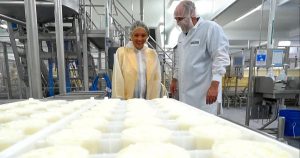
Based on data summarized in the most recent U.S. Dairy Exporter Blog:
Value basis: January-June 2022 exports were valued at $4.8 billion, up $1 billion (27%) from the same period in 2021.
Volume basis: U.S. cheese exports grew by 31% (+10,349 metric tons, or MT) year over year in June. Through the first half of 2022, U.S. cheese exports grew by 17% (+33,556 MT), easily on pace to smash the previous annual record.
Exports of U.S. whey products increased by 23% (+10,531 MT), as Southeast Asian buyers secured supplies and volumes held steady to China – the largest single whey importer in the world by a wide margin. Lactose exports saw similar levels of growth (+22%, 7,426 MT).
Beyond the major categories, the U.S. expanded its portfolio to include gains in milkfat-heavy products. Butter jumped 63% (+2,272 MT), anhydrous milkfat more than tripled (+225%, +1,695 MT), whole milk powder climbed significantly (+83%, +1,695 MT), and even evaporated/condensed milk saw substantial growth (+77%, +883 MT).
Nonfat dry milk/skim milk powder (NFDM/SMP) was the only major product to see an export decline in June (-14%, -11,288 MT). According to USDEC, the primary obstacle to growing NFDM/SMP exports remains a lack of supply.
Milk solids basis: January-June exports totaled 1.2 billion pounds on a milk solids equivalent basis, up 2% from the same period in 2021.
Driving success
USDEC cites multiple factors in driving cheese and whey exports:
First, despite limited milk production growth in the U.S., cheese production has managed to expand.
Second, U.S. cheese has been relatively affordable on the global market, both on a spot basis and in futures markets for the majority of the first half of the year.
Pricing factors have also favored U.S. cheese suppliers in key buying regions like Mexico and Central America, where cheese prices are more competitive with cheaper alternatives using palm oil instead of dairy fats. Demand in Latin America is further aided by a strengthening peso, raising purchasing power for imports while local milk production remains weak.
Finally, the rebound in Chinese pig prices that began in mid-April and peaked in July likely also supported June whey export volume.
What’s ahead?
Along with the factors mentioned above, the USDEC report said the recovery in U.S. shipping is helping lift overall U.S. export volumes. Mitigation measures, including creation of pop-up container facilities, threats to implement dwell time fees to ocean carriers and the implications of the Ocean Shipping Reform Act, are beginning to make a difference as delayed product secures passage aboard ocean vessels.
After declining for most of the final three-quarters of 2021, the number of loaded outbound 20-foot equivalent shipping units (TEUs) leaving major California ports has been slowly ticking upward this year.
While the West Coast dockworkers contract remains a big shipping unknown, the improvement in container flow bodes well for U.S. dairy export efforts heading into the back half of 2022 – particularly as more attention is paid to correcting additional supply chain choke points.
Economic growth and inflation (from dairy input costs to retail prices) will continue to create export headwinds, but the supply chain arguably is looking up for the first time since before the pandemic, according to USDEC.
For more, read: U.S. dairy exports soar in June, climbing 9%.





















